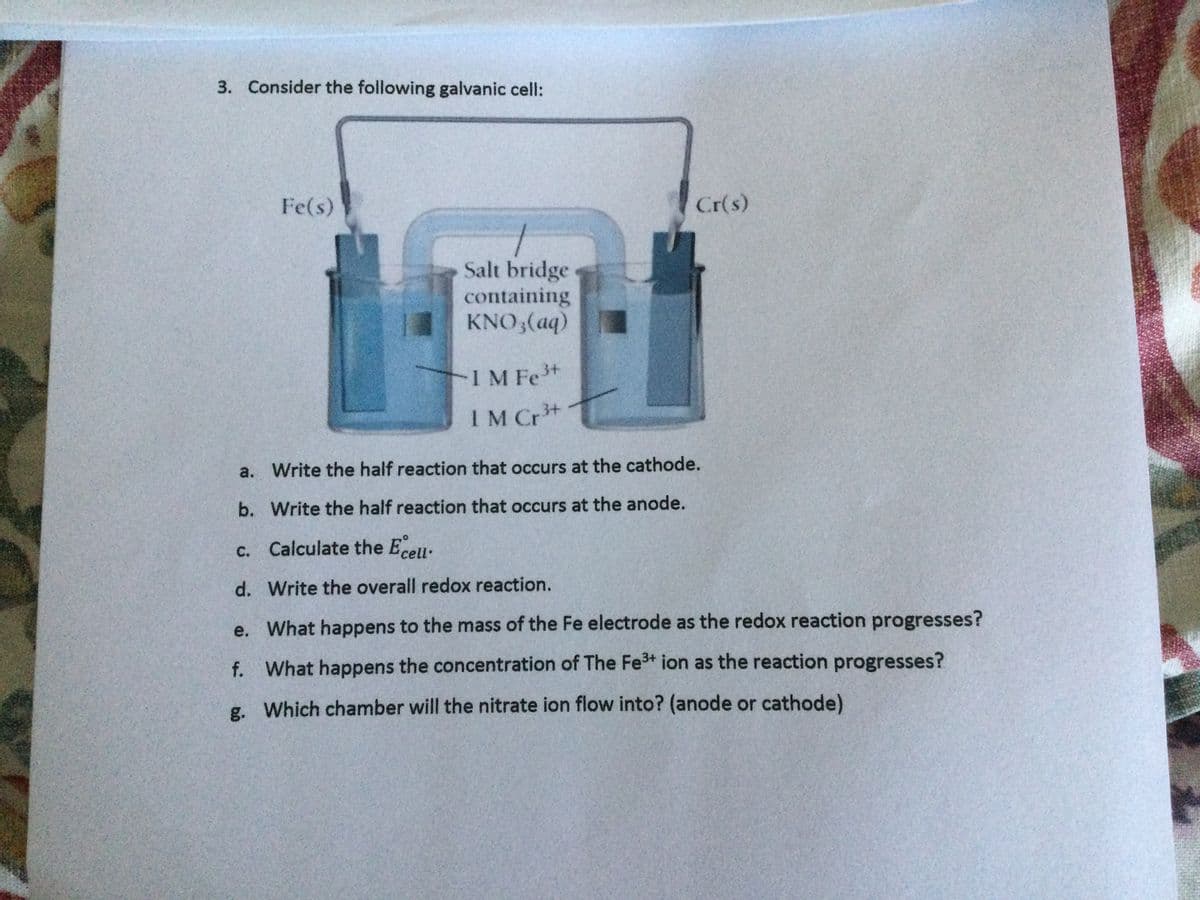3. Consider the following galvanic cell: Fe(s) Cr(s) Salt bridge- containing KNO,(aq) IM Fe+ IM Cr+ a. Write the half reaction that occurs at the cathode. b. Write the half reaction that occurs at the anode. c. Calculate the Ecell. d. Write the overall redox reaction. e. What happens to the mass of the Fe electrode as the redox reaction progresses? f. What happens the concentration of The Fe3+ ion as the reaction progresses? g. Which chamber will the nitrate ion flow into? (anode or cathode)
3. Consider the following galvanic cell: Fe(s) Cr(s) Salt bridge- containing KNO,(aq) IM Fe+ IM Cr+ a. Write the half reaction that occurs at the cathode. b. Write the half reaction that occurs at the anode. c. Calculate the Ecell. d. Write the overall redox reaction. e. What happens to the mass of the Fe electrode as the redox reaction progresses? f. What happens the concentration of The Fe3+ ion as the reaction progresses? g. Which chamber will the nitrate ion flow into? (anode or cathode)
Chemistry: Principles and Reactions
8th Edition
ISBN:9781305079373
Author:William L. Masterton, Cecile N. Hurley
Publisher:William L. Masterton, Cecile N. Hurley
Chapter17: Electrochemistry
Section: Chapter Questions
Problem 105QAP: Consider a voltaic cell in which the following reaction occurs. Zn(s)+Sn2+(aq)Zn2+(aq)+Sn(s) (a)...
Related questions
Question
100%

Transcribed Image Text:3. Consider the following galvanic cell:
Fe(s)
Cr(s)
Salt bridge
containing
KNO,(aq)
-1M Fe+
IM Cr+
a. Write the half reaction that occurs at the cathode.
b. Write the half reaction that occurs at the anode.
c. Calculate the Eceu.
С.
d. Write the overall redox reaction.
e. What happens to the mass of the Fe electrode as the redox reaction progresses?
f. What happens the concentration of The Fe+ ion as the reaction progresses?
g. Which chamber will the nitrate ion flow into? (anode or cathode)
Expert Solution
This question has been solved!
Explore an expertly crafted, step-by-step solution for a thorough understanding of key concepts.
This is a popular solution!
Trending now
This is a popular solution!
Step by step
Solved in 2 steps

Knowledge Booster
Learn more about
Need a deep-dive on the concept behind this application? Look no further. Learn more about this topic, chemistry and related others by exploring similar questions and additional content below.Recommended textbooks for you

Chemistry: Principles and Reactions
Chemistry
ISBN:
9781305079373
Author:
William L. Masterton, Cecile N. Hurley
Publisher:
Cengage Learning

Chemistry by OpenStax (2015-05-04)
Chemistry
ISBN:
9781938168390
Author:
Klaus Theopold, Richard H Langley, Paul Flowers, William R. Robinson, Mark Blaser
Publisher:
OpenStax

Chemistry: An Atoms First Approach
Chemistry
ISBN:
9781305079243
Author:
Steven S. Zumdahl, Susan A. Zumdahl
Publisher:
Cengage Learning

Chemistry: Principles and Reactions
Chemistry
ISBN:
9781305079373
Author:
William L. Masterton, Cecile N. Hurley
Publisher:
Cengage Learning

Chemistry by OpenStax (2015-05-04)
Chemistry
ISBN:
9781938168390
Author:
Klaus Theopold, Richard H Langley, Paul Flowers, William R. Robinson, Mark Blaser
Publisher:
OpenStax

Chemistry: An Atoms First Approach
Chemistry
ISBN:
9781305079243
Author:
Steven S. Zumdahl, Susan A. Zumdahl
Publisher:
Cengage Learning

Chemistry
Chemistry
ISBN:
9781305957404
Author:
Steven S. Zumdahl, Susan A. Zumdahl, Donald J. DeCoste
Publisher:
Cengage Learning


Chemistry & Chemical Reactivity
Chemistry
ISBN:
9781337399074
Author:
John C. Kotz, Paul M. Treichel, John Townsend, David Treichel
Publisher:
Cengage Learning